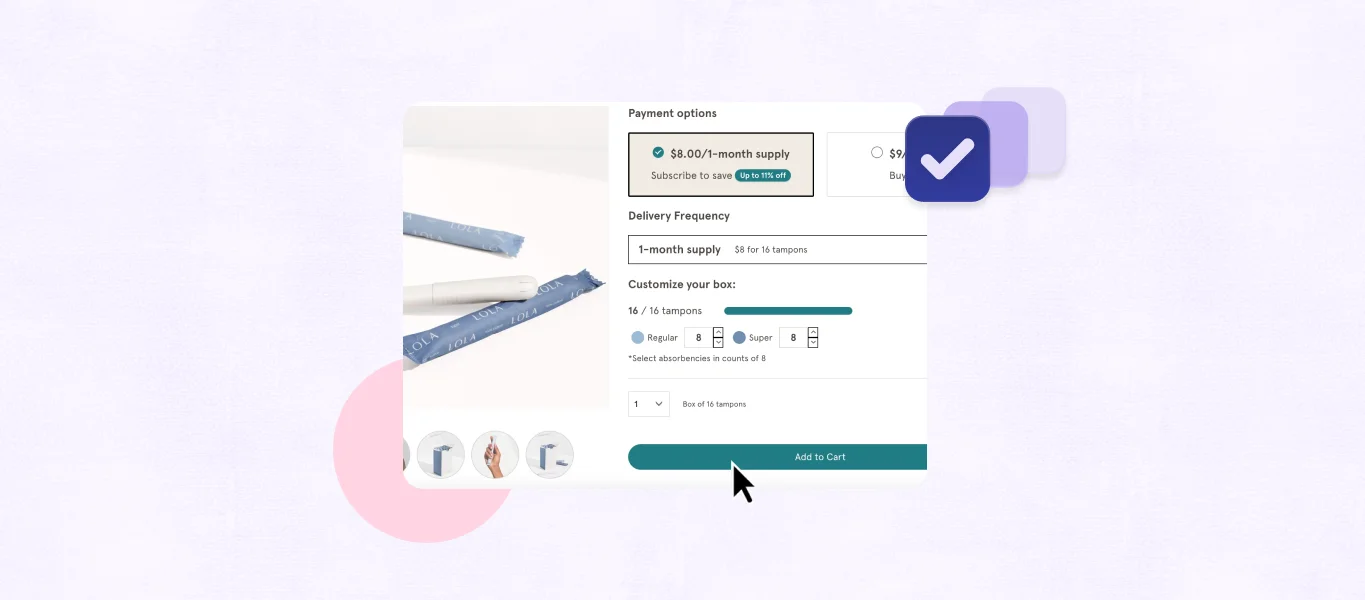If you’re a merchant who has always dreamed about starting your own subscription business but aren’t sure where to begin, then you’re in the right place. This post will explore what the subscription business model is and give you a better understanding of the steps you’ll need to take to start offering subscriptions, like choosing the right subscription management platform, building a website, and launching a marketing strategy.
The subscription model has been gaining momentum for some time—the global subscription ecommerce market is expected to reach $2.64 trillion by 2028, according to UnivDatos Market Insights. Merchants who’d like to reap the benefits of the subscription model—and there are many, for both you and your subscribers—should start implementing subscriptions right away by following the checklist below.
Key takeaways
- The subscription industry is growing and offers many benefits to both customers and businesses.
- Merchants who’d like to start offering subscriptions should follow this straightforward checklist for starting an ecommerce subscription business.
- Subscription management solutions can help online stores launch their subscriptions faster, and with a seamless customer experience.
What is the subscription business model?
Before you can start offering subscriptions as a service, it’s crucial to fully understand this business model and exactly how your business can achieve recurring monthly revenue. Anyone interested in starting a subscription business will need to identify a need for their subscription offering, whether that’s supplementing customers’ pantries with everyday items or offering a subscription box service that surprises customers each month with new products.
There are three different types of subscription models:
- Curation: Curation is the most popular subscription box business model—merchants assemble a box of curated products (or let shoppers build their own) and send them directly to their customers.
- Replenishment: The replenishment model is often referred to as the “subscribe-and-save” model because merchants will typically offer discounts to their repeat customers. It’s a great model for subscription businesses who sell products that customers use on a regular basis.
- Access: Access is a subscription model which includes memberships, and gives exclusive access to early releases, gated content, discounts, and more.
The foundation of all subscription-based businesses is to sell products or services on a recurring basis, no matter which of the three models a merchant follows. Shoppers input their credit card information once and are charged at a regular cadence. Depending on your subscription services, that time period can span from weekly to monthly to yearly. Some subscription businesses might also consider letting customers choose their own cadence, or offer prepaid subscriptions so shoppers can gift your products on repeat.

Are you new to subscriptions?
The subscription model of ecommerce might seem intimidating at first, especially for merchants who have never offered subscriptions before. However, with the right subscription management solution, your business can launch subscription offerings in no time. Our new interactive guide helps online stores select the best ecommerce subscription platform for their business—taking into account your unique business needs and your priorities as a subscription business.
Subscription management platforms will help your business keep subscriptions running smoothly. Not only do they facilitate collecting recurring revenue in a safe and secure way, but they also will help your business create a seamless customer experience. These software solutions give both subscribers and merchants the ability to manage their subscriptions, making sure you can offer the best experience for shoppers and keep customer retention high.
How to start a subscription business: Checklist for those new to subscriptions
Now that you have an idea about the value of recurring revenue and more information about the subscription-based business model, let’s explore the steps merchants can take to launch their own subscription boxes or services.
1. Identify your product or service
Identifying your subscription business idea is the first step for any new subscription business. What type of product or service would you like to sell on subscription, and does it make sense to offer it on a recurring basis? Will you be selling a curated subscription box or simply replacing everyday products when customers run out?
These are important questions for merchants to ask themselves as they begin the process of starting their subscription business. Of course, if you already have an existing online store with a loyal customer base, you might also be considering adding a subscription option. Think about your products or services and if the subscription-based business model would be a good fit for your store. Take into account your existing and potential customers—would having your offerings on subscription add value to their lives?
2. Select a subscription management solution
Before you develop a marketing strategy or think about business growth, you’ll need to choose a subscription management solution. If you’re wondering what a subscription management solution is, let’s dive into it before we go any further.
What is a subscription management solution?
These software solutions are made for subscription businesses, allowing them to optimize their subscription processes with a variety of tools and features. Every subscription business can utilize a management solution—they will ensure a smooth customer journey, since their main goal is to handle customers’ subscriptions. This includes the process of how you as a merchant allow your subscribers to handle their own subscriptions.
Typically, subscriptions management software includes a mixture of manual and automated actions, which can include:
- Issuing refunds
- Making changes to an order
- Offering discounts to subscribers
- Skipping a delivery
- Swapping an item
- Adding on products to an order
Our new, interactive guide gives merchants the ability to make an informed decision when choosing their subscription management platform. Once you’ve selected the software to back your subscription-based business, you can move on to the next steps.
3. Create a website for your subscription boxes
If your subscription business is new, then you’ll need to create a website to sell your products. Online shoppers care about the appearance of your site and its usability, meaning it’s more than worthwhile to spend time creating a beautiful website for your customers. Consider your target market: How do they shop? What kind of content appeals to them?
Furthermore, the customer portal is an integral part of any subscription service. From the portal, your existing customers can modify their orders. Whether subscribers need to swap a product, skip an order, or update their billing information, the customer portal should be easy and straightforward to use. When you make subscriptions flexible, you’ll greatly reduce customer churn.

4. Price your items based on the subscription model
Starting a subscription business of course also entails pricing your items for a subscription. Consider packaging and shipping costs when determining prices on your products or services. Many subscription business models also offer discounts to their customers as a thank you for continuing to purchase items on a regular basis. You might also consider another pricing strategy, like psychological pricing or special access to free shipping for subscribers.
5. Start marketing your subscription box business
Having your own subscription box business includes turning your business idea into a real product, then creating a marketing strategy to sell your subscriptions. If you want reliable cash flow from recurring revenue, you’ll need to think about the best customer acquisition strategies for your target market, as well as customer retention so you can keep the customers you win over.
Here are a few ideas merchants can use to get started on their marketing plan:
- Utilize social media platforms to market your product or service
- Share an informative blog post or create YouTube videos for your target audience
- Consider influencer marketing to spread the word about your subscription offerings
- Promote brand loyalty with a rewards program

6. Begin taking subscription orders
Once you have the software platform in place and have started marketing your subscriptions to existing and new customers, it’s time to start taking orders. As you grow your subscription-based business, you’ll see how much easier it is to forecast inventory and revenue thanks to the subscription business model. Not only do subscription companies have the ability to build strong customer relationships over time, but they can also expect steady business growth as they gain more subscribers and start earning recurring revenue.
Setting your business up for success with subscriptions
Many subscription businesses credit the subscription-based model for their success. When customers return month after month, year after year, online stores can enjoy the benefits of lower customer churn and higher customer lifetime value. Following the steps outlined above, merchants starting a subscription business can ensure they find the right subscription management solution and create a seamless customer journey for their subscribers.
Sources
[1] How to choose your subscription management solution (Recharge)
[2] Subscription E-Commerce Market: Current Analysis and Forecast (2021-2028) (UnivDatos Market Insights)
[3] What is subscription management? (Recharge)
[4] The secret behind psychological pricing: Subscription boxes (Recharge)



